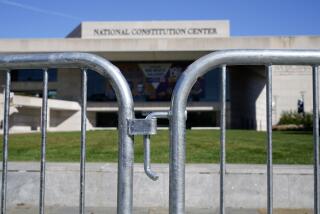The Iran Deception : REAGAN’S GREATEST CRISIS : The Money Flow: How The Deals Were Made
- Share via
After six years of magic, President Reagan broke the spell. By deceiving the nation, he and those around him badly damaged his presidency. This traumatic tale is still unfolding, with no end in sight. This is how it developed.
Secrecy and sensitive political considerations complicated the Iran arms transactions, prompting creation of a complex financial network to help conceal the fact that arms were sold and also the existence of business relationships among the buyers, sellers and middlemen. Investigators are still trying to unravel the tangled financial web and determine where all the money went. This is what we now know about three of the deals.
AUGUST, 1985 / The First Transactions: 1. After meetings with Israeli, American and Iranian officials, Saudi Arabian businessman Adnan Khashoggi assumes the role of key middleman in government-sanctioned arms deal. 2. Khashoggi deposits $5-million in a Swiss bank account. It is a “bridge loan,” payment in advance guaranteeing that the arms sellers will be paid once the arms are delivered to the buyers. 3. With Israeli arms merchant Jacob Nimrodi making the arrangements, 504 American-made TOW anti-tank missiles are flown to Iran from Israeli stockpiles in August and September. 4. Iran, upon receipt of the missiles, pays $5-million to Manucher Ghorbanifar, Iran’s agent in the transaction. He transfers the funds to Khashoggi’s Monte Carlo bank account. 5. Khashoggi transfers between $3-million and $4-million to the Swiss account of the Israeli Ministry of Defense to pay for the missiles. 6. In the end, Nimrodi reportedly receives about $1-million for his efforts and to cover shipping expenses; Khashoggi reportedly receives about $250,000 in commissions; Ghorbanifar’s share is unknown. 7. About three months later, the United States fills an Israeli order for 504 missiles to replenish its stock. FEBRUARY, 1986 / The U.S. ships directly: 1. With the help of investors, Khashoggi raises $10-million to finance another arms transaction. 2. Khashoggi, through his Monte Carlo bank, establishes a $10-million account to guarantee payment for arms. 3. Khashoggi moves $10-million to the Geneva bank account of Lake Resources, a shell company controlled by Lt. Col. Oliver North, to pay for arms shipments. 4. Arms and spare parts are shipped to Iran directly from the United States. 5. Upon receipt of the arms shipment, Iran pays Ghorbanifar an unknown amount. 6. Ghorbanifar issues four separate checks totaling $12-million to Khashoggi. Profits, if any, made by Ghorbanifar are unaccounted for. 7. Khashoggi returns investor funds. It is unclear how he allocated the $2-million profit. MAY, 1986 / Early Diversions? 1. Khashoggi borrows $15-million from Cayman Island bankers, possibly pledging assets controlled jointly by himself and various Canadian partners. 2. Khashoggi transfers $15-million into a Swiss bank account of Lake Resources, controlled by North. 3. The money is supposed to pay for arms to be shipped to Iran. However, some of it is suspected of being diverted to the contras. Later sources of profit may also have been diverted through this account. 4. The U.S. sends partial shipments of arms and spare parts directly from American stockpiles. For unknown reasons, the remainder of the arms deliveries is delayed. 5. Iran pays Khashoggi about $8-million for deliveries so far but refuses further payments until additional equipment arrives. There are suggestions that Iran was overcharged. 6. Khashoggi, pressed by his bankers and Canadian partners, threatens to sue the United States and blow the secrecy of the operation. 7. At last report, Khashoggi and the Canadians claim to be owed more than $10-million ($7-million in unreimbursed loans, $3-million for “handling charges” and unspecified interest).
More to Read
Sign up for Essential California
The most important California stories and recommendations in your inbox every morning.
You may occasionally receive promotional content from the Los Angeles Times.










